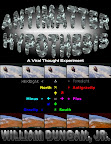 A comparative analysis of paradigms, from ancient through modern sources, reveals a unified, ubiquitous pattern underlying reality. At the core of existence, one elemental set of building blocks appears pervasive, and research indicates that many generations have interpreted and transcribed this primordial structure into transformative, progressive, cultural contexts.
A comparative analysis of paradigms, from ancient through modern sources, reveals a unified, ubiquitous pattern underlying reality. At the core of existence, one elemental set of building blocks appears pervasive, and research indicates that many generations have interpreted and transcribed this primordial structure into transformative, progressive, cultural contexts.A paradigm, in its own terms, explains or describes aspects of common experience from a unique perspective - like trying to reconstruct a statue from a collection of blurry snapshots. How many photographs, or video segments, are adequate to fully capture a family vacation, a day in the news, the year in review, a lifetime of memories, or a person’s character? Absolute truth may ultimately prove elusive. Increasing detail amounts to overload at the expense of general comprehension. Paradigms help us recognize the universal in the wild.
A collection of pictures taken from various viewpoints increases the recorded detail of a statue, like the opinion of a jury. By comparing and combining multiple paradigms, a universal pattern emerges through reinforced similarities, lending fresh insights into the big picture, into ourselves, and into the fabric of existence. These sources arise from diverse fields of study, and cover disciplines in human nature and in the nature of reality.
As children we learn language. We notice patterns. Regularities get reinforced. As we master patterns of speech, our communication skills grow and our understanding improves. Common ground gets established, and we learn to express our needs with greater eloquence and efficiency.
Paradigms facilitate our ability to communicate novel concepts and develop mutual understanding. Gistmass Ubiquity Theory supplies the framework that not only governs the universe but ourselves as well.
More Gistmass Ubiquity Theory









No comments:
Post a Comment